Lindzen's Clouded Vision, Part 2: Risk
Posted on 9 May 2012 by dana1981
In Part 1 of this post, we examined the fundamental flaws in the last hope for climate contrarians - that the planet won't warm very much in response to rising greenhouse gas (GHG) emissions, because climate sensitivity is low, because clouds will act as a negative feedback and dampen future warming. While it would be convenient if this picture (best embodied by Richard Lindzen) were accurate, the evidence is stacked heavily against it.
Nevertheless, as Part 1 concluded, there is a slim chance that Lindzen and company are correct, that climate sensitivity is low and global warming is not a major concern. There is also a high probability that they are wrong, that future global warming will be substantial, and that the consequences will be bad if we don't do something about it. How we choose to address these scenarios is a question of risk management, which happens to be a big part of my day job. Unfortunately, as with his scientific positions, Lindzen's risk management arguments are ill-conceived.
Irrational Optimism
In the Gillis New York Times article, Lindzen summarizes his approach to this climate risk management question:
"If I’m right, we’ll have saved money...If I’m wrong, we’ll know it in 50 years and can do something."
There is a rather obvious flaw in Lindzen's logic here - it assumes that in 50 years we will be able to simply flip a switch and solve the climate problem. Unfortunately, that is probably not the reality of the situation. Figure 1 shows the projected atmospheric CO2 levels under various emissions scenarios. If we listen to Lindzen, we will follow one of the higher emissions paths (currently we are on track with A2 [yellow]). Figure 2 shows the resulting global warming based on climate model runs which, as Part 1 showed, have thus far been quite accurate.
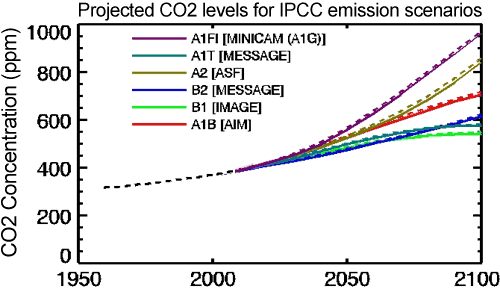
Figure 1: Atmospheric CO2 concentrations as observed at Mauna Loa from 1958 to 2008 (black dashed line) and projected under the 6 IPCC emission scenarios (solid colored lines). (IPCC Data Distribution Centre)
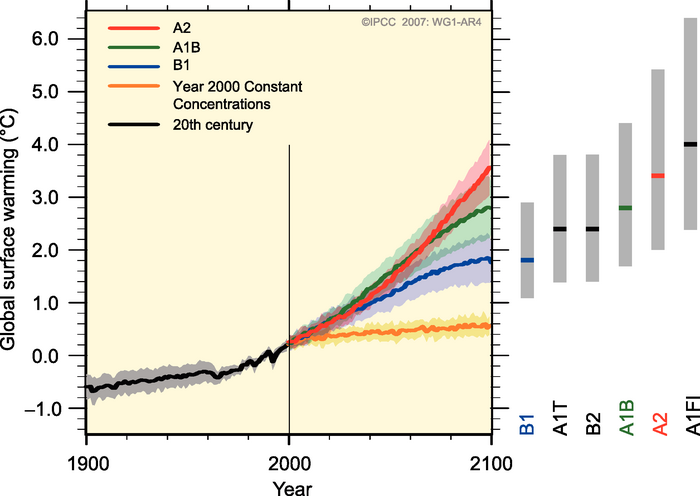
Figure 2: Global surface temperature projections for IPCC Scenarios. Shading denotes the ±1 standard deviation range of individual model annual averages. The orange line is constant CO2 concentrations at year 2000 values. The grey bars at right indicate the best estimate (solid line within each bar) and the likely range. (Source: IPCC).
The big difference between the higher and lower emissions scenarios is that at mid-century, emissions in the higher scenarios are accelerating upwards, while in the lower scenarios they are flattening out. It takes time to deploy the necessary infrastructure to reduce GHG emissions - there is no magical switch we can suddenly flip in 2050 when we realize that Lindzen and company were wrong. As Figure 2 shows, the average global surface temperature difference between Scenario A2 (essentially business-as-usual advocated by Lindzen) and Scenario B1 (which involves serious action to reduce GHG emissions) in 2100 is close to 2°C.
What's Dangerous?
Internationally, 2°C warming above pre-industrial levels is generally accepted as the "danger limit" we should try to avoid exceeding. This is not a hard and fast limit - there won't suddenly be a catastrophe if we reach 2.01°C; in fact, many experts believe even 2°C warming is too risky. However, some of the impacts listed in the IPCC report for global warming of a Lindzen-level 3-4°C above pre-industrial levels include:
-
hundreds of millions of people exposed to increased water stress
-
30–40% of species at risk of extinction around the globe
-
about 30% of global coastal wetlands lost
-
increased damage from floods and storms
-
widespread coral mortality
-
the biosphere – soils, plants etc – stops absorbing carbon and starts releasing it
-
reduced cereal production
-
increased death and illness from heat waves, floods and droughts.
In Scenario A2, we reach this level of warming in about 60 to 80 years - within a couple of decades of Lindzen's 50 year 'wait and see' target. If he is wrong, by the time we're forced into taking action, it will be too late to avoid some really nasty consequences.
And of course let's not forget global warming's evil twin, ocean acidification. Even if the contrarians are right about low climate sensitivity, the impacts of rising atmospheric CO2 on marine ecosystems will be severe, and a 50-year delay in reducing CO2 emissions could have dire consequences for those ecosystems.
In short, if Lindzen is wrong, future generations are in big, big trouble. In fact, according to The Critical Decade report by the Australian Climate Commission, we've already burned through 30% of our allotted GHG emissions between 2000 to 2050 if we want to give ourselves a good chance to limit global warming to that 2°C limit. Not only don't we have 50 years, we're already behind where we should be in terms of emissions reductions.
Risk Management 101
Humans are generally very averse to risk. Everyone who drives a car purchases auto insurance. Everyone who owns a house purchases homeowners insurance. Most first world countries have implemented universal health care systems, and in the USA, virtually everyone who can afford it purchases health care insurance. Personally I'm relatively young and in good health, I'm a safe driver, and I'm not worried that anything will happen to my home; yet I've purchased all three types of insurance. Why?
Because if anything were to do substantial damage to my home, car, or health, it could impose a huge cost which I couldn't afford without insurance. The probability of any of these things happening is relatively low, but the potential consequence is so bad that we all mitigate it by purchasing insurance to cover our most valuable assets in case the worst case scenario comes to fruition.
Yet when it comes to the climate, we are behaving in exactly the opposite manner. It's hard to imagine a larger potentially diastrous scenario than a major climate change. It could potentially impact every single living thing on Earth, and impose a huge cost on every person. This is not just some slim possibility, as shown in Part 1, it's the most probable outcome! And yet thus far we have utterly failed to mitigate this massive, highly probable risk.
This is the risk management approach I described in my entry in Why Are We Sure We're Right, and as Greg Craven has eloquently summarized in this video. However, to adequately manage the risks posed by climate change, we should perform a cost-benefit analysis.
Mitigation Costs
The costs associated with mitigating climate change are relatively straightforward to evaluate. Generally, estimates put the cost of reducing GHG emissions 80% by 2050 (which will approximately limit global warming to the 2°C 'danger limit') at around 1% of Gross Domestic Product (GDP). Some estimates put the cost as low as a fraction of a percent of GDP, while others put it as high as 2 to 3%. While this is a substantial cost, it is not an unmanageable one, and we already have all the technology necessary to accomplish this task.
It's also worth noting that the longer we wait, the larger the costs become. Delays force emissions cuts to be steeper, and they also delay the development of cheaper emissions reductions technologies. A Google.org study found that delaying significant investment in green tech by 5 years could cost the USA $2.3 to $3.2 trillion in GDP (Figure 3).
Figure 3: US GDP gains between 2010 and 2050 in three scenarios. The green scenario includes a $30 per ton price on utility sector CO2 emissions and strong investment in green tech to develop "breakthroughs" (BTs). the blue line depicts a scenario in which there is heavy investment in green tech without a carbon price. The purple line is a 5 year delay before significant investment in green tech. The red and orange area depicts the difference in GDP growth: $2.3 to 3.2 trillion lost in the 5 year delay scenario. Source: Google.org study
Mitigation Benefits
The benefits of climate mitigation are more difficult to estimate, because it depends who's right. If Lindzen and company are right about low climate sensitivity, then reducing GHG emissions has some relatively small benefits. For example, countries will produce more domestic energy and become more energy-independent. National security will improve as oil-based wars become less likely. The transition away from fossil fuels, which are after all non-renewable and limited substances, will be smoother and easier. Air and water pollution and their associated adverse health impacts will be reduced.
Installing the necessary infrastructure would also create a lot of jobs and help alleviate the current unemployment problems around the world. Right now, when there is a major surplus in the available work force, is arguably the best time for governments to invest in infrastructure projects like those which will be necessary to reduce GHG emissions.
So there are some definite benefits to reducing emissions even if the Lindzen low sensitivity crowd is right. If they are wrong, which is the far more likely scenario, the benefits will outweight the costs several times over, by trillions of dollars (Figure 4).
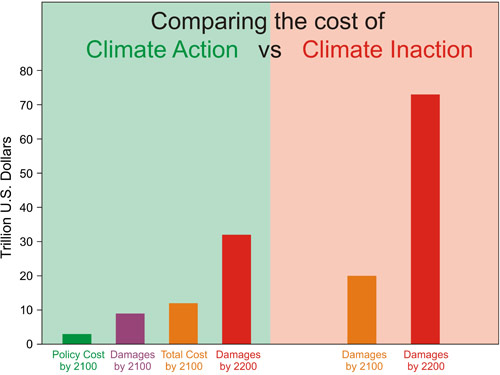
Figure 4: Approximate costs of climate action (green) and inaction (red) in 2100 and 2200. Sources: German Institute for Economic Research and Watkiss et al. 2005
'Fingers Crossed' is Poor Risk Management
Lindzen's suggested approach of waiting 50 years and hoping the consequences are not disastrous is one of exceptionally poor risk management. The prudent approach would involve addressing the worst case scenario, particularly when that scenario has a significant probability of coming to fruition if we fail to prevent it. This is particularly true when the mitigation costs, while not cheap, will certainly not cripple the economy, and when the benefits are also significant in any scenario, and may very well outweigh the costs several times over and by trillions of dollars.
From a risk management standpoint, there is no question that we should be ignoring Lindzen's ill-conceived approach and instead taking serious action to reduce our GHG emissions. Unfortunately, for various reasons, we have thus far failed to take the prudent climate risk management approach, and if we continue to fail, future generations will suffer the consequences of Lindzen and his fellow contrarians' foolhardy approach.































 Arguments
Arguments





















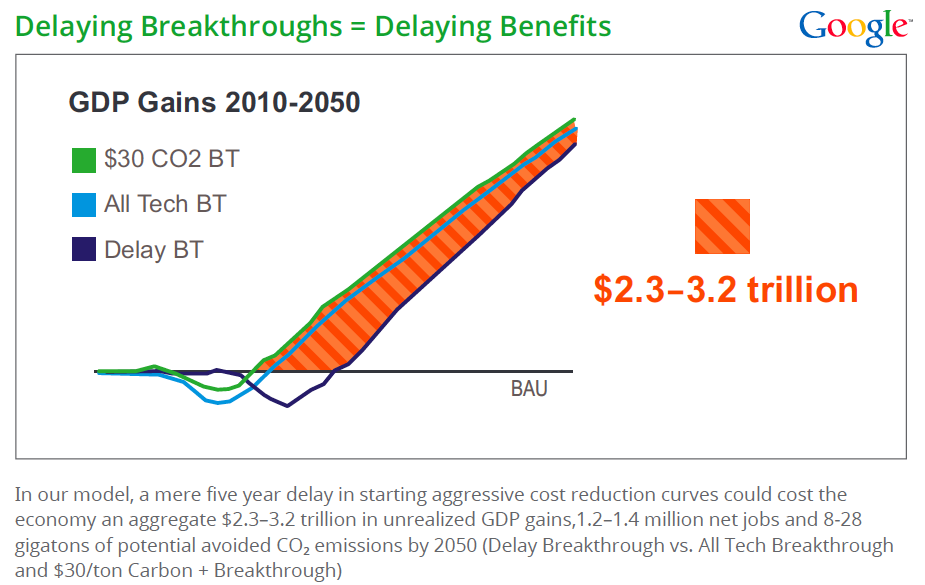


 1
1  0
0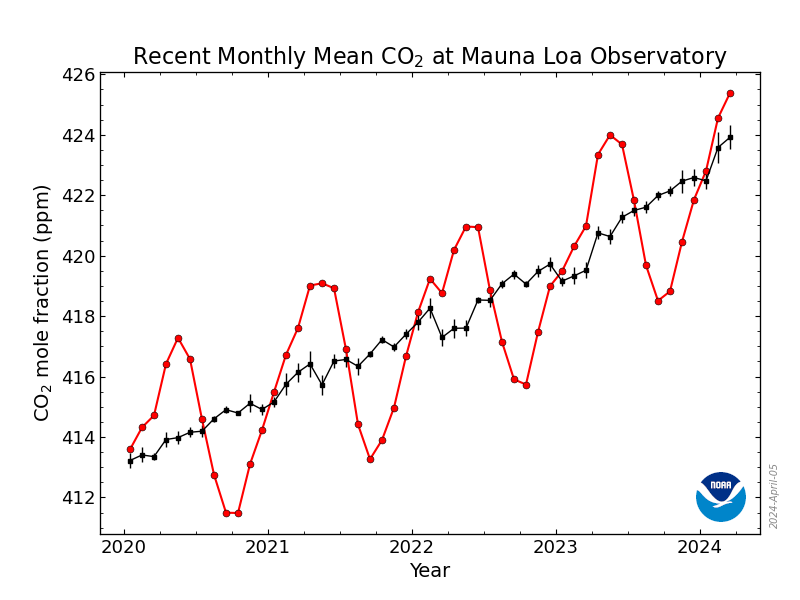 One more month of rise before the seasonal peak is reached. This possibly puts 400 ppm within reach in May 2013...
One more month of rise before the seasonal peak is reached. This possibly puts 400 ppm within reach in May 2013...
 (middle red line above is ensemble mean for Sokolov)
Betts et al 2011 (blogged on by Romm here), published in the Royal Society A, details a 4C world by 2070...
(middle red line above is ensemble mean for Sokolov)
Betts et al 2011 (blogged on by Romm here), published in the Royal Society A, details a 4C world by 2070...







Comments